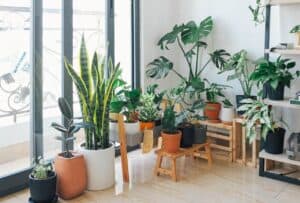
In this blog post, we’ll explore why plants are important for well-being. You’ll find inspiration and exercises to help bring positive plant energy into your day.
The Amazing Benefits of Plants: A Biological Need
According to Psychology Today, the benefits of indoor and outdoor greenspaces are the following:
- Stress relief
- Reduced symptoms of depression
- Better memory retention
- HIgher productivity and concentration
- Increased creativity
Being in a space with plants improves everything from stress relief to brain health, depression to immunity.
Having grown up in green environments, I always wondered how city dwellers could thrive in such a seemingly harsh urban landscape.
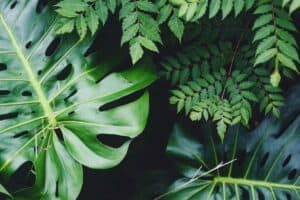
Actively Seeking Green Spaces
When we were in NYC last March right as the flowers started to bloom, I realized how people in the city intentionally seek plant life, either consciously or subconsciously. And it is EVERYWHERE, you simply have to look.
Walking along the sidewalks, there was an excitement you could feel, punctuated by brightly blooming tulips at the base of each tree.
There’s a reason why gardening is on the increase among Millenials (+65%) and Gen Z (+44%).
We thrive in the presence of plants!
According to the National Garden Center, over half of US households report having a garden. The numbers are still heaviest with homeowners, but with changes brought about by the pandemic, the demographics are shifting.
It’s exciting to see that urban agriculture is on the rise, as is public interest in developing greenways in cities.
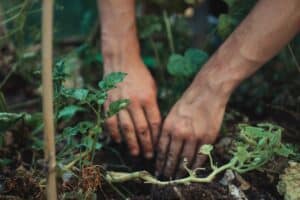
The Most Densely Populated City in the US Has it Right
Think of the most densely populated city in the US as an example: According to the NYC Mayor’s Office of Climate and Justice, NYC Parks has planted over a quarter million new trees since 2016. (For more information, check out their website.)
In 2022, the mayor announced a $7.25 million federal grant to expand the greenway network into underserved communities, regreening neglected parks and giving children in Brooklyn and other boroughs nourishing, green spaces to play in.
Walking through Central Park, it was fun to see the enthusiastic volunteers working on projects around the park.
As we walked through the Shakespeare Garden, we stopped to chat with a woman with wiry gray hair, who was knee-deep in greenery, pulling weeds. She was so “in the zone” that she looked a little surprised that we were speaking to her.
She pointed out some of the blooms that had opened in the past few days, and she encouraged us to keep going up the path to look for columbine flowers. As we thanked her for her dedication, she said: “I need this!”
With park development underway along the waterfront, and the continued loving maintenance of the High Line, one of the most densely populated areas of the city vibrates with plant life.
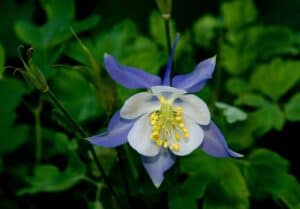
How to Get More Plants into Your Life Today
It doesn’t matter where you live or how little space you have. Even the smallest amount of greenery will give you significant benefits. Live in a small apartment? If you have a windowsill or a small balcony, consider buying a potted plant.
Or if you’re into the idea of watching your own food grow, see if you can grow a favorite veggie in a pot. Basil is a fan favorite that thrives in a pot, and its uplifting scent will ignite your senses.
Salad greens are another favorite, and so satisfying to grow since they sprout quickly and are easy to maintain. With a few medium sized pots, you could grow a salad. Try greens, radishes, and even carrots if you go for a rectangular planter. Baby carrots are fun to grow!
Make a plan to spend half an hour or so at a garden center to get yourself all set with a pot or two, soil, and some seeds. Heck, you can even get your plants at Walmart or Lowe’s, though I prefer to support local garden centers.
We grow a 600 square foot vegetable garden, which is a lot of work (since we live in the harsh conditions of the high desert). I will say, though, that digging into the soil is one of my favorite ways to refocus my brain.
If you don’t want to plant seeds, take the easy route and purchase a potted plant. Tropical plants do well in low-light areas (think Pothos, Weeping Fig, or Peace Lily) and are powerhouses when it comes to bringing oxygen into your home.
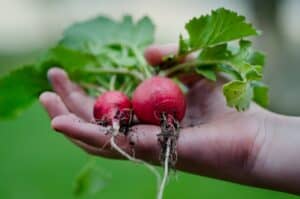
Exercise: Collect Plant Imagery
According to the Journal of Environmental Psychology, even viewing an image of nature provides immediate relief after a psychologically stressful event.
I guess we already know that our screen savers help lower stress. But did you know a botanical abstract painting will, too?
The next time you are out thrifting, checking out flea markets, or have a chance to peruse a craft fair, look for realistic or abstract images of plants.
Wouldn’t that handmade card look great in a cute frame? Make a grouping of 3 and put it near your journaling spot. For a low cost and without getting your hands dirty, you can bring some healing energy to your apartment or home.
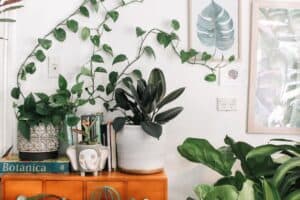
Exercise: Look Closely at a Plant
The simplest way to bring some plant energy into your reality quickly is to look closely at a plant. Whether you have a succulent on a windowsill, or a tree outside your back door, there is bound to be a plant you can use for this exercise nearby.
Close Looking Exercise (Up to 15 Minutes)
As with most exercises where your intention is to slow down and initiate a relaxation response, see if you can extend your inhale and exhale gradually so you are breathing at a slower pace.
- Sit comfortably near your plant so it is in your direct view.
- First, look at the plant as a whole making general observations without getting caught up in labeling.
- If possible, pick up your plant or touch an element of your plant such as a leaf.
- Look at it closely for a few minutes, noticing the differences in texture and color, and whether there is a shadow on parts of the plant.
- Now imagine the root system feeding the plant. Observe your plant as a system, sensing its inner workings (don’t worry, you don’t have to have it scientifically correct!).
- To wrap up, close your eyes and breathe deeply, sensing the green, living energy of the plant expanding outward and soothing you.
I hope this experience of looking closely at a plant brings you joy today!
Anytime your nervous system needs relief, or you feel a little jangled from too much screen time, even 5 minutes of observing nature will help bring you back to a natural, nourished energy state.
Be a plant-loving version of yourself.
get tips and topics in the weekly newsletter
Get useful mindfulness tips and topics to your inbox each Sunday. You’ll receive a free gift when you sign up.
I promise, no spam. And I will never sell your information.